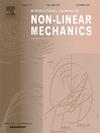Combined time-pressure gradient and electric field on the electroosmotic flow of a complex fluid (human blood data) in a concentric annular microchannel: Linear and non-linear cases with the exponential structure rheological constitutive equation
IF 2.8
3区 工程技术
Q2 MECHANICS
International Journal of Non-Linear Mechanics
Pub Date : 2025-07-14
DOI:10.1016/j.ijnonlinmec.2025.105207
引用次数: 0
Abstract
This study explores theoretically how a time-dependent, pulsatile pressure gradient combined with an electric field affects the flow of a structured electro-viscoelastic fluid in an annular space. The fluid's behavior is described using an extend version of the nonlinear viscoelastic constitutive equation with an exponential structure kernel (ESR-S). This updated ESR model incorporates solvent-related forces, resulting in the ESR-S formulation, which captures complex non-Newtonian behaviors such as shear thinning/thickening, thixotropy, yield stress, elasticity and normal stress differences. Dimensionless variables are introduced to characterize the geometry, material properties, and driving forces, In the linear viscoelastic regime, transfer functions are derived using Fourier analysis, revealing resonance behavior at specific frequencies governed by the Womersley and Deborah numbers. In the nonlinear regime, flow enhancement is predicted based on material characteristic and external mechanisms, including electric and thermal effects. The study shows that combination of a pulsatile pressure gradient and an electric field can significantly enhance flow, particularly when specific dimensionless parameters are met. This effect is demonstrated using rheological data from human blood samples with varying cholesterol levels, where high-cholesterol samples exhibited a distinct flow pattern suggesting a potential diagnostic indicator for hypercholesterolemia. The main objective is to theoretically evaluate the extended ESR-S model for predicting coupled flow behavior in both linear and nonlinear regimes.
复合时间压力梯度和电场对复杂流体(人体血液数据)在同心环形微通道内电渗透流动的影响:线性和非线性情况下的指数结构流变本构方程
该研究从理论上探讨了随时间变化的脉动压力梯度与电场结合如何影响环空空间中结构化电粘弹性流体的流动。流体的行为用非线性粘弹性本构方程的扩展版本与指数结构核(ESR-S)来描述。更新后的ESR模型包含了与溶剂相关的力,从而产生了ESR- s公式,可以捕获复杂的非牛顿行为,如剪切变薄/增厚、触变性、屈服应力、弹性和法向应力差异。引入无量纲变量来表征几何形状、材料特性和驱动力。在线性粘弹性体系中,使用傅立叶分析推导传递函数,揭示由沃默斯利和德博拉数控制的特定频率下的共振行为。在非线性状态下,流动增强是基于材料特性和外部机制(包括电效应和热效应)来预测的。研究表明,脉动压力梯度和电场的组合可以显著增强流动,特别是当满足特定的无量纲参数时。这种效应通过不同胆固醇水平的人类血液样本的流变学数据得到证实,其中高胆固醇样本表现出独特的血流模式,这表明高胆固醇血症可能是一种诊断指标。主要目的是从理论上评价扩展ESR-S模型在线性和非线性条件下预测耦合流动行为的能力。
本文章由计算机程序翻译,如有差异,请以英文原文为准。
求助全文
约1分钟内获得全文
求助全文
来源期刊
CiteScore
5.50
自引率
9.40%
发文量
192
审稿时长
67 days
期刊介绍:
The International Journal of Non-Linear Mechanics provides a specific medium for dissemination of high-quality research results in the various areas of theoretical, applied, and experimental mechanics of solids, fluids, structures, and systems where the phenomena are inherently non-linear.
The journal brings together original results in non-linear problems in elasticity, plasticity, dynamics, vibrations, wave-propagation, rheology, fluid-structure interaction systems, stability, biomechanics, micro- and nano-structures, materials, metamaterials, and in other diverse areas.
Papers may be analytical, computational or experimental in nature. Treatments of non-linear differential equations wherein solutions and properties of solutions are emphasized but physical aspects are not adequately relevant, will not be considered for possible publication. Both deterministic and stochastic approaches are fostered. Contributions pertaining to both established and emerging fields are encouraged.

 求助内容:
求助内容: 应助结果提醒方式:
应助结果提醒方式:


